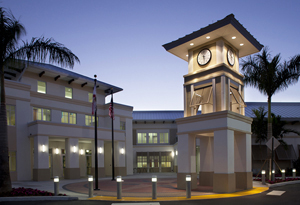A long discussion about white vinyl fencing on residential properties concluded on Wednesday, June 19, when Wellington’s Architectural Review Board decided to leave the controversial material off the village’s approved colors and materials schedule.
Senior Planner Damian Newell conducted the presentation and explained that all members would need to vote as a full board on the issue. After an extensive conversation, the panel voted 5-2 against the use of white vinyl fencing.
The issue arose last November when the board finalized its latest schedule of approved colors and materials. At that time, a board member made a motion to allow white vinyl fencing back on the approved list.
The minutes from the meeting when it was last discussed, years earlier, recorded the extensive discussion on the matter in a few short, unenlightening sentences. The motion last November failed. Instead, the board asked staff to come back with more information so they could make a more informed decision with the current board. The surprisingly divisive discussion has since been postponed several times.
Newell showed the board approved fencing options, which included fence types in a PowerPoint presentation. Residents can use board-on-board fencing; shadowbox fencing; vinyl-coated chain link in brown, black and green colors; aluminum rail in bronze, black and white; and finally, PVC/vinyl in beige, tan and gray. If a property is on a right-of-way, a hedge is required. If the fence is vinyl-coated chain link, it also must have a hedge.
Staff recommended that white fencing be allowed, but not on thoroughfare roads. Residents have complained about not being able to have white fencing in residential neighborhoods.
However, white fencing has not been allowed for some time. The main complaint from the Architectural Review Board is that white stands out, especially when it is stained or situated next to a fence of another color.
Board Chair Ron Shamash said that the issue of white fencing dates back a number of years.
“I am glad we have a full board to have a full discussion,” he said. “We started this discussion back in 2013 because we had issues with those fences around full developments where residents were upset when the perimeter fence was not maintained. Recently, when I am driving around, I see a white vinyl fence and it looks nice, but when I see it stained, dented or warped, it looks horrible because it is an eyesore that jumps out at you.”
Board Member William Klein made a motion to permit white PVC and vinyl fencing, except on thoroughfares and side streets, and to include that developments could not use white fencing on perimeters.
Klein opposed unsafe fences, but not necessarily the material.
“My feeling is it is appropriate for us to say no to unsafe fences like those that might have broken glass or spikes on top, but not on this type of material,” Klein said. “There is nothing wrong with the material. From a code perspective, do we have a code in place that prohibits the type of degradation that the residents are concerned about.”
He noted that the village has strong code enforcement to keep the issue in check.
“I asked for a request to the village on how many cases there were of degraded fences or degraded landscaping on fencing in 2017 and 2018,” Klein explained. “The answer that came back was that there were about 500 a year. So, that is pretty good enforcement.”
Klein said that Wellington is an outlier on this issue.
“We are the only municipality in the top 11 that prohibit the use of white vinyl fences,” he said. “Are we, as individuals, taking away a cost-effective option for our residents? We should change our policy and allow white vinyl fencing.”
Board Member Stacy Somers remained skeptical.
“We are talking about the thoroughfares with a meaning of concern for the aesthetics of the village, and not the residents,” she said. “The seven of us are here on behalf of all of the residents who also live within the community.”
When the vote was called, Klein and Board Vice Chair Tom Wenham voted yes, while Shamash, Somers, Miguel Alonso, Roger Grave de Peralta and Ryan Michkin voted no.
In other business:
• The board approved signage for the McDonald’s restaurant at Village Green Center with some technical deviations. The motion passed unanimously. Gigie Simeon, project manager for Mastec Network Solutions, was on hand to answer questions.
• A vote was held for the board’s chair and vice chair over the next year, and both Shamash and Wenham were returned to those roles.








